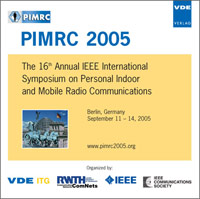Throughput and Fairness Improvement in 802.11b Multi-rate WLANs
Konferenz: PIMRC 2005 - 16th Annual IEEE International Symposium on Personal Indoor and Mobile Radio Communications
11.09.2005 - 14.09.2005 in Berlin, Germany
Tagungsband: PIMRC 2005
Seiten: 5Sprache: EnglischTyp: PDF
Persönliche VDE-Mitglieder erhalten auf diesen Artikel 10% Rabatt
Autoren:
Zhang, Liang; Shu, Yantai (Department of Computer Science, Tianjin University, Tianjin 300072, China)
Yang, Oliver W. W. (School of Information Technology and Engineering, University of Ottawa, Ottawa, Ontario, Canada, K1N 6N5)
Inhalt:
The 802.11 standard supports multiple data transmission rates. To achieve a high performance under varying conditions, wireless stations need to adapt their transmission rate dynamically. Typically, stations with 802.11b products would reduce their bit rate from 11 Mbps to 5.5, 2, or 1 Mbps if they are far away from an Access Point (AP) and subject to significant signal fading and interference. This leads to considerable rate diversity, particularly when the network is congested. Under such conditions, aggregate throughput of WLANs will be degraded drastically because the basic CSMA/CA channel access method would guarantee an equal long term CAP (Channel Access Probability) to all hosts. The main contribution of this paper is the proposal of an algorithm that can be implemented at both the AP and the Wireless Stations (WSs) with the purpose of guaranteeing fairness and improving the aggregate throughput of 802.11b muti-rate WLANs. We use COT (Channel Occupancy Time) as fairness index instead of the CAP to analyze the fairness of WLANs. With our algorithm, the AP and wireless stations in the WLAN can achieve COT-based fairness by adjusting their packet length, sending the multiple back-to-back packets at one time, or giving up an opportunity to access the channel. Through exclusive simulations, we show that our algorithm leads to significant improvements in aggregate throughput and provides COT-Fairness under multi-rate condition.


